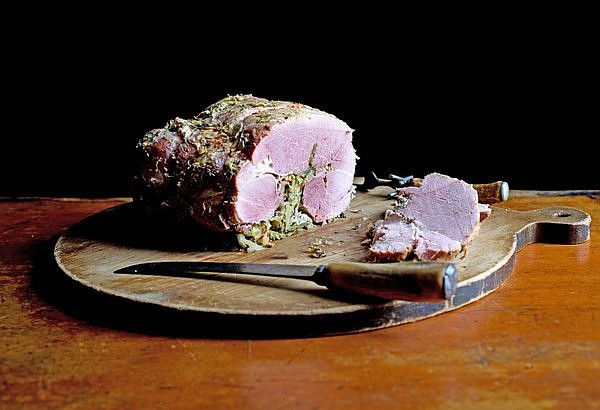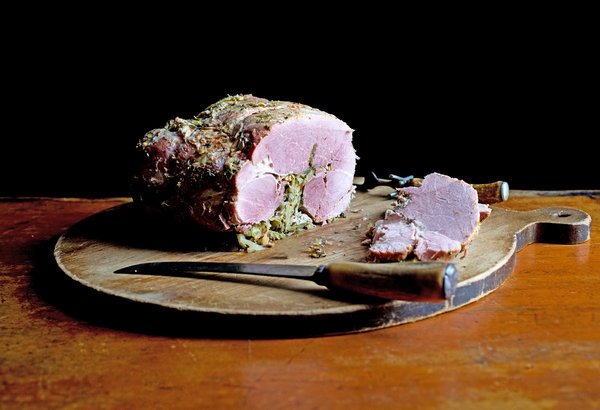TALL TIMBERS, Md. - William Andrew Dent was the stuffed ham king around here.
Dent, whom everyone called Andy, died in his sleep last month. He was 56. His brother, David, said the cause was probably a heart attack.
About eight years ago, the Dent brothers took over a little grocery store with a bar and restaurant in the back from their father. He had worked there for years and finally bought it in the 1970s. That was around the time W.J. Dent & Sons, the only grocery store in this town of about 500, was building its reputation for having some of the best stuffed hams in Southern Maryland.
Unless you've lived in St. Mary's County or spent a holiday with someone from here, you've probably never heard of stuffed ham. Like Cincinnati chili, Jersey Shore rippers and the collard sandwiches of Robeson County, North Carolina, it is one of America's most regionally specific dishes, but has never migrated beyond its home. People here cherish it.
There was a time when you'd be hard-pressed to find a family in St. Mary's County that didn't make a stuffed ham, at least for Thanksgiving, Christmas or Easter. But here, as everywhere, home cooking waned. Families got smaller. The will and skill needed to boil 20 pounds of cabbage-stuffed ham faded. People turned to country stores like Dent's to fill the gap.
"We have the second-best stuffed ham in the world," Andy Dent told me in an interview at his bar the day before he died. "Your grandmother's is the best. But ours is easier."
Capturing the precise recipe is like trying to get an artist to explain how to paint a landscape. Still, there are common building blocks. You start with a corned ham, which is a whole, fresh ham that has taken a long vacation in salt. (Good luck, by the way, finding one outside the county - especially one that weighs less than 20 pounds.)
Next, you chop several pounds of cabbage, kale and onions, then perk it all up with enough black and red pepper "to give it some bite," as cooks here say.
From there, the recipe diverges into a debate that runs the length of the county. In the north, cooks will tell you to add a lot of kale. In the south, kale is just an accent color, if it goes in the stuffing at all. Whether mustard seed, celery seed or celery itself belongs in the stuffing depends on the version you grew up eating.
The stuffing is packed into pockets cut deep into the meat with techniques that vary from cook to cook. What's left over - and there will be a lot left over - is pressed around the ham. The whole thing is wrapped in cheesecloth (or a clean pillowcase or T-shirt) and boiled for four or five hours.
Then, you drain the ham and set into the refrigerator to chill, although plenty of people just leave it in the cooking liquid out on the back porch during cool weather. You slice it cold, serving the ham as a main dish or tucked into soft potato rolls or between slices of white bread. Don't ask about mustard or mayonnaise. You don't want to start an argument.
A ham stuffed with cabbage simmering on the stove for hours makes a lasting olfactory impression - and not necessarily a good one. Unprompted, even the ham's biggest fans allow that the smell can linger for days.
How stuffed ham became the specialty of St. Mary's County isn't a question with an easy answer, said Joyce White, a food historian in Maryland.
The ham has a very distant British cousin called stuffed chine. The dish, from Lincolnshire, is made from a brined chunk of pork taken from between the shoulder blades. Herbs are stuffed into slashes in the meat, and then the whole thing is boiled in muslin.
White and other regional historians say it's more likely that the dish has Afro-Caribbean roots; indentured or enslaved West Africans would season the greens and onions left over in the winter garden with red pepper, and stuff it into jowls or whatever chunks of pork they had on hand.
But as in so many parts of the South, the line between black and white food is blurry.
Stuffed ham recipes have shown up in "The Virginia Housewife," which Mary Randolph published in 1824, but the ham is smoked. Recipes with cabbage and brined ham are more prominent in "300 Years of Black Cooking in St. Mary's County," which was published in 1975 and traces the history of the ham back centuries.
"It floated up and got adopted into the white food traditions," White said. "When you're cooking and you can't read, you are going to follow your own instinct and taste but adjust it for the white people for whom you are cooking."
The result is an amalgam of a dish, with a cooking method that has been developed and passed on in classic folk tradition - with generations of observation and repetition, both in black households and white.
Stuffed Ham, Southern Maryland Style
Yield: 8 to 12 servings, plus leftovers
Total time: 5 1/2 hours, plus chilling and corning
1/2 of a fresh or corned ham (8 to 12 pounds)
1 cup kosher salt plus more, if corning
3 pounds green cabbage
1 pound curly kale, or a mixture of other greens like mustard greens or watercress
2 medium yellow onions (about 1 pound)
1 bunch scallions (about 7)
1 1/2 tablespoons coarsely ground black pepper
1 1/2 tablespoons red-pepper flakes
1 tablespoon mustard seed
1 tablespoon celery seed
1 teaspoon cayenne
1 tablespoon salt
If corning the ham: Cut slits about 3 inches deep in a few places around the bone. Push salt into the incisions and, with a light hand, rub salt all over the surface of the ham. Reserve any remaining salt to rub into the ham as it corns, adding more if needed later in the process. Place the ham in a nonreactive pan, cover tightly with plastic wrap and then aluminum foil and place it in refrigerator for a week. Unwrap and turn it every couple of days, sprinkling with more reserved salt and pouring off any juice that collects each time. Rewrap. The day before you are going to stuff the ham, rinse off the salt and soak the ham overnight in cold water in the refrigerator.
Make the stuffing: The goal is to chop all the vegetables so the pieces are small and relatively uniform in size. Begin by chopping the cabbage. A food processor with a shredding blade is helpful. Place the cabbage in a large pan or bowl. Remove large stems from the kale and other greens, if you are using them, and chop. (Tip: Freeze cleaned, whole kale leaves overnight in plastic bags, then break up the frozen leaves while still in the bag and add to the stuffing mixture.) Chop the yellow onions and scallions, and add them to the cabbage and kale.
Mix the vegetables well and add the spices. Mix again. (Your hands will work best for this, but wear gloves if your skin is sensitive to pepper.) Taste the stuffing and adjust, adding more cayenne or red-pepper flakes for a more intense spiciness. Keep in mind that the long boiling time will soften the heat.
Stuff the ham: Remove the bone, or have the butcher remove it for you. The ham should be almost butterflied. Add the bone to a pot large enough to hold the ham, fill with enough water to cover it and begin to heat the water to a boil.
While the water heats, set the ham on a sheet pan and cut slits about 3 inches long and 2 inches deep in a few places to make pockets, being careful not to slice through the meat completely. The number of slits will depend on the size of the ham. The goal is an even distribution of stuffing. Pack the slits tightly with stuffing, and add stuffing to the center of the ham where the bone was. Close the ham and secure it with kitchen string.
Prepare a large square of cheesecloth at least 3 layers thick. Spoon a layer of stuffing over the cheesecloth and set the ham on it. Pack more stuffing on the top and sides of the ham. Gather the corners of the cheesecloth to the top and twist tightly to form a compact package. Tie the top tightly with string.
Lower the ham into boiling water, reduce heat to a simmer and add any juice that has collected from the stuffing. Skim any foam that rises. Cook, covered, for about 15 minutes per pound, or until the internal temperature reaches 165 degrees.
Turn off the heat and let the ham cool slightly in the water, about an hour. (Old-timers simply put the whole pot on the porch overnight if the weather was cool, or left it on the stove until completely cooled.) Drain the ham in a colander, and refrigerate for at least 6 hours or overnight. Remove the cheesecloth and string, and reserve any stuffing around the ham.
To serve, slice the ham across the grain, so each slice contains stuffing and meat. Pile additional stuffing around the slices. The ham can be reheated, but more often it is served cold.

